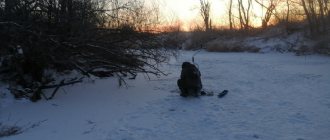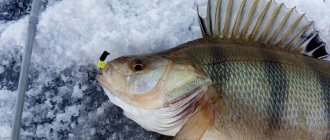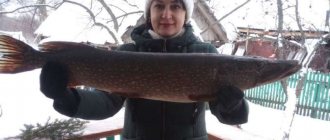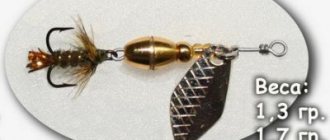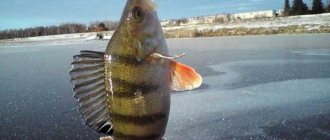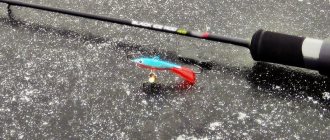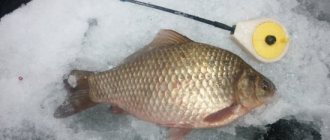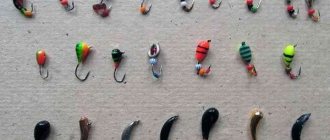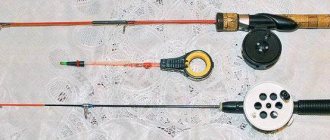To catch pike perch on the first ice, you should not rely on unbridled hunger or luck. Yes, the fanged one is active at this time. However, it does not stand everywhere on the reservoir, and does not wander everywhere, like schools of hungry perch. Despite this, pike perch is a predictable fish. If you master the nuances of tactics taking into account the peculiarities of fish behavior, problems arise in fishing.
In the first ice conditions, there are no problems with the fanged fish biting. It’s more important to find the fish, but catching it is a matter of technique. There is another difficulty here - not in all reservoirs it is possible to walk on thin, fragile ice to the treasured edges and exits from the pits. Let's take a closer look at how to catch pike perch on the first ice, where to look for a predator and what gear to use.
Fishing for pike perch from ice
Throughout the winter, pike perch feeds. Naturally, at low water temperatures, the predator’s metabolism is slowed down, and to maintain its vital functions it does not need as much food as it does in summer. However, even in winter, the fangfish has periods of active hunting for fry. Fishing for pike perch on the first ice from the point of view of biting is one of these promising periods.
The usual resting places for pike perch - deep edges near the riverbed - are the last to freeze. When fishermen manage to get to them (on rivers with strong currents), the first ice has, by and large, ended long ago. However, on small reservoirs and medium-sized calm rivers the ice rises earlier, and it is easier to get to the fanged fish here without the risk of swimming in icy water.
Article about the features of catching winter pike perch
Types of gear for first ice
You can catch pike perch on the first ice using several tackles. Each of them can bring trophy fish if handled skillfully.
Sheer trolling rod
One of the most catchy tackles at the beginning of winter is a spinner. This is explained by the fact that the predator’s mobility on the first ice is high. There is intense competition in the flock, so the fanged robbers try to instantly grab the food item. And only after getting into the mouth of the fish can determine its inedibility.
To make a catchy tackle for trolling from ice, you will need the following elements:
- rod with cork handle;
- a hard whip equipped with guide rings;
- inertial reel or meat grinder with 1000 spool;
- monofilament with a diameter of 0.22-0.28 mm.
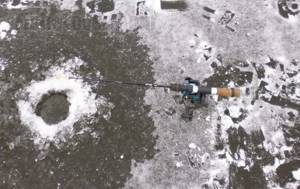
Photo 1. Winter lure.
Helpful information! It is better to make the rod with the ability to replace the whip. By selecting feeder quivertypes, you can find the optimal option for flexibility.
Of the variety of artificial baits, you should stock up on:
- vertical spinners;

Photo 2. Winter zander spoons.
- balancers;

Photo 3. Balancers and rattlin.
- jigs;
- rattlins;
- amphipods;
- silicone fish.
Zherlitsa
If you follow the simplest safety measures, you can hunt for predators on the first ice using zherits. Depending on the reservoir, choose a classic tackle or an option with a diverting leash.
- The classic equipment of a fishing rod is chosen when fishing in bodies of water with standing water or a small current. The over-ice part can be anything from a traditional wooden stand to plastic bases. The fishing line is equipped with a sliding sinker, a silicone stopper and a hook.
Recommendation! The weight of the sinker is selected according to the weight of the live bait. The ratio should be approximately 1:10.
- There are places where pike perch stay on the river where it is more profitable to install several guards on duty. In such cases, equipment with a retractable leash is required. A sinker is tied to the end of the main line; its weight should be such as to hold the rig in the current. At a distance of 40-50 cm from the sinker, a retractable leash with a hook is mounted. You can connect the leash to the fishing line using a loop-to-loop method or through a swivel.
The best fish for a fanged predator would be:
- silver bream;
- white bream;
- bleak;
- roach;
- gudgeon;
- goby.
Postavusha
Fishermen came up with special equipment to catch pike perch in winter using sprat. Instead of this fish from the herring family, any small live bait can be used. The advantages of sprat lie in its special smell, which the fanged predator loves. The sprat is used dead.
The gear consists of a rod equipped with legs, a reel, a bright guard, and monofilament 0.22-0.28 mm. The equipment looks like this:
- A large jig or small jig head is tied to the end of the fishing line. Sometimes fishermen make special lures for sprat.
- At a distance of 40-50 cm from the lower jig, a leash for the second live bait is mounted. Instead of natural fish, silicone imitation can be used.
On the first ice, it is enough to catch pike perch with 2-3 sets, in the future their number can be increased to 5 pieces.
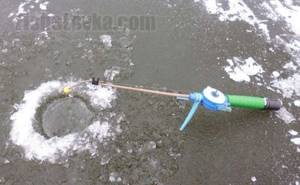
Photo 4. Fishing for pike perch.
Pike perch in the first ice
Whether fishing for pike perch on the first ice will be successful or not depends entirely on local conditions, the speed and time of ice formation. The predator is active, but its feeding and parking spots can be reached everywhere. For example, even if the river is not completely frozen, you need to fish on the edges in those places where the deep channel comes close to these areas. Although access to the lower edges themselves is still limited, you can catch the fanged one on the approaches to them, where it goes out to feed.
If the reservoir is completely frozen, all possibilities for finding and catching fangs open up before the fisherman. In principle, all the gear works. Pike perch, like perch, actively fattens its mass. However, depending on the specific conditions of the reservoir, it can stand in different places, and feed according to a schedule.
Occasionally you can get caught up in a meal - but this is more luck than a trend. You need to look for fish. If a flock is found, there are usually no difficulties with catching it. Therefore, ice fishing for pike perch is a constant movement and search, just like for perch, only on a larger scale.
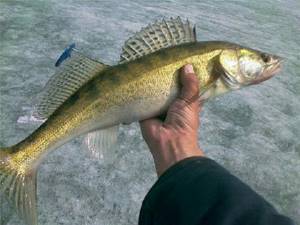
Search
In order for catching pike perch on the first ice, as in other periods of winter, to be successful, you need to rely not on zhor, but on your own legs. The more points you go through and check, the more likely it is that luck will smile on the fisherman. Unlike perch and pike, the main habitats of pike perch are mainly found in large bodies of water, large rivers and reservoirs.
In such vast expanses, pike perch sticks to strictly defined places that need to be looked for. Experienced pike-perch fishermen carefully hide their treasured spots. The fanged fish, especially in large reservoirs, lives in the same places year after year, and goes out to feed along the same paths. Therefore, successfully worked points need to be remembered, for example, recorded in a GPS navigator.
Where to look for pike perch on the first ice
Standard pike-perch spots work:
- Steep bottom breaks, edges, drops, entrances and exits from pits.
- Snags, deep spits and shell rocks.
- On a homogeneous topography there are areas with uneven bottoms and colonies of shells.
- On rivers, when the depth gradually decreases on one bank and there is a sharp drop on the other, the pike perch will always adhere to the steeper slope, being in its lower part.
- The lower part of the cans and navels, rising above the depths.
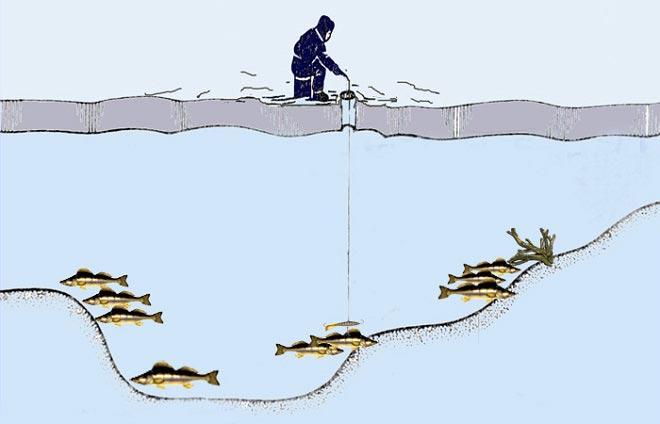
If in reservoirs the determining factor for pike perch is the bottom topography, then in rivers the current is also added to it. The fanged one will not stand on the stream itself - it will choose a point nearby, on a quiet one, if it is convenient from the point of view of the relief. There is no need to look for pike perch in flat, deep-water areas - there is nothing interesting for the fanged fish there. But the edge of the pit, especially with uneven bottoms and irrigation with thickets nearby, are interesting. The predator will settle in the depths and come out ashore to hunt.
- For the first ice, it is often necessary to check not the deep-sea points themselves, but the shallower water areas adjacent to them. Walleye are active now and can feed in relatively shallow water all day.
- On large rivers and reservoirs, schools of pike perch can move significantly during the day following schools of silver bream, blue bream and other fish. Hence the driven methods of fishing for fanged fish. Pike perch in reservoirs on the first ice should be caught in large areas around their usual winter habitats.
- The predator is active and can move a considerable distance away from its parking points while hunting. So, if the strategic location of the fanged fish is known, we catch and check the entire area around a promising dump or edge, from the shallow side. The fanged one in the first ice can be anywhere in this zone.
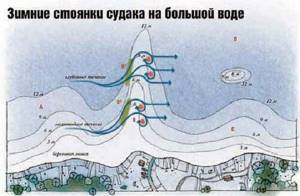
Fishing tactics and techniques
The correct choice of tactics plays an important role in catching pike perch. Fishermen specializing in catching fanged predators use several interesting methods. Such tactics are called corralling.
- Spinners most often become beaters spontaneously. Typically, anglers come to a pond and start looking for fish at some distance from each other. They are caught using different types of artificial baits. As soon as a pike perch is caught, neighboring anglers begin to gradually get closer to the lucky one. Then the same thing is repeated with other members of the spontaneous community. As a result, a dense group of spinners is formed, which can reach several tens or even hundreds of people. The crowd moves synchronously after the feeding predator. During the day, a flock of people migrates across the reservoir, sometimes decreasing, sometimes increasing.
- Driven fishing for pike perch in the zherlichniks takes place somewhat differently. These people purposefully gather in small groups of 4-6 people. A battery of vents is installed along the channel edge. After some time, splitting in half, they move away in different directions from the riverbed for about 20 m. Armed with large, heavy spoons, they begin to actively lure. Gradually, the fishermen approach the line of the girders, not reaching 4-5 m. If after 2-3 approaches (total duration about 1.5-2 hours) none of the flags light up, all the girders move along the channel edge for 50-60 m. And the drive was repeated again. The meaning of this tactic is simple. Large baits frighten the pike perch, forcing it to move towards the girders. The predator becomes more aggressive when it sees a small fish on a hook; it attacks it without hesitation.
In order to get a decent pike perch from under the ice shell at the beginning of winter, the angler should be attentive to the actions of experienced colleagues. At first glance, funny and illogical behavior can become the key that will open a secret door into the world of a cautious fanged predator.
Fishing tactics
The route fishing method is used in large water areas with many possible habitats for pike perch. You need to think about where to go in advance. Holes are drilled only in promising places so as not to waste time. A good fall can be checked more thoroughly by drilling holes at a distance of 7-10 meters to check the entire area. You can walk 10-15 km in a day like this. When the ice gets stronger, a snowmobile or motorized dog helps in this matter.
- If it is not known for certain that there are definitely pike perch here, you don’t need to spend a lot of time on the hole. A dozen moves of a spinner, balancer or rattlin - and we move on.
- The driving method works if there are a lot of anglers on the ice and the fish are constantly moving. Where pike perch appear in such towns is immediately noticeable - anglers begin to fish in a specific area. There is no need to collect belongings and rush to them in a herd. It’s better to take a closer look, determine in which direction the bite is moving, quietly gather and sit in that direction, and wait for the fish.
- An experienced fishing group will never run to a lucky comrade and drill him from all sides at the same time - this will only scare away a school of fanged fish, and no one will catch anything. You need to move into the working area one by one and quietly, drill carefully without pumping one at a time, so as not to frighten off a school of pike perch that is easy to climb on the first ice.
- The driven method works when installing vents on a mass scale. But this is only possible if all fishermen in the group act together. The drains are installed on dumps and shallow water areas overlooking them. Anglers move 100 meters away from this zone (if on a river, downstream), drill holes and play with large pike lures. The pike perch is frightened by the massive drilling and strong vibrations of a dozen spinners, rises higher along the edge, and stumbles upon the girders. He will grab live bait not out of hunger, but out of aggression. Then everything is repeated, but at the next section upstream.
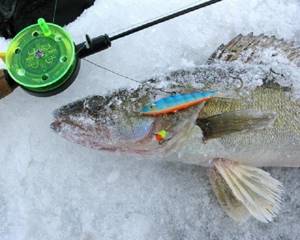
Fishing rod
A lure for pike perch is suitable for any configuration, both factory and homemade. The whip must be elastic and hard enough to cut through the hard mouth of the fanged one. The simplest version of a homemade fishing rod is an unnecessary feeder quivertip glued into a cork handle or piece of wood. The fishing rod is equipped with an inertial reel or a multiplier - it’s not for everyone. Some fishermen use reels, but reels are more convenient to work with.
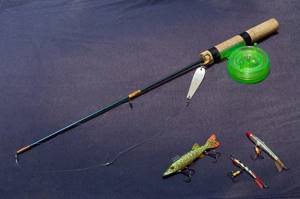
A pike perch can strike instantly on the first ice, so you can’t waste a lot of time when the bite starts – you need to catch it. The bite may not last long, and it is this moment that often makes fishing. Therefore, there should be one more ready-made fishing rod in stock. If during the moments of biting the main one gets tangled, breaks off, or fails in any way, we take the second one without wasting time on fixing the first one.
A 0.25-0.45 mm monofilament is wound onto a reel - this is enough to catch pike perch of any size with the proper skill. Read more about the right winter fishing rods for pike perch
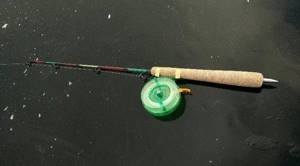
Spoons
The most common bait for pike perch is winter vertical spinners. It is better to attach an additional irritant to the hook of the spoon - a red cambric or a bristle brush. Spoons for pike perch need nails or loose lures, but not gliding ones, like for pike. Light sea jigs will also work. Sufficiently heavy baits from 8 grams and above are used, allowing you to work comfortably at depth. You shouldn’t chase all the variety of models – it’s better to master a few basic ones and fish with them.
Pike-perch is interested in baits that fall into place quite quickly after being dropped, but at the same time make long-decaying oscillations. The fanged one gets irritated and reacts precisely to the monotonous game - it brings him to the grip. The most valuable spinners are those that quickly complete the fall and strong vibrations, but take a long time to produce micro-movements.
Basic fishing for pike perch is a rise without a strong jerk of 20-30 cm with slight acceleration, and then a long pause, from 7 to 30 seconds. It is during the pause that the fanged one usually grabs. In this case, the bite is usually well transmitted to the hand. But pike perch can also take it when the spoon is falling - but after lifting the usual care and straightening of the fishing line is not observed. A sudden weight in your hand is also most likely a bite.
In addition to spinners, you can use the same fishing rod with other baits - balancers, ratlins, amphipods, jig heads with silicone or replanting sprat.
Article about winter trolling of pike perch: https://podlednik.ru/lovlya_zimoj/khishhniki/blesny-na-sudaka
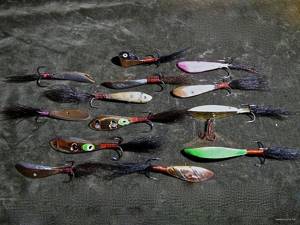
Amphipods and Mormoblesses
Balancers
Baits with active action - balancers - also work for pike perch. However, sharp somersaults of the bait have a negative effect on this fanged predator. He is more attracted to monotonous twitching. For active pike perch on the first ice, conventional balancers with a plastic tail work better. However, if the fish is passive, baits with a tassel on the tail perform better. Which do not make strong lateral jumps when wiring. In any case, zander requires a less intense game than perch. Do not pull too hard - this will scare away the fanged one. Uniform monotonous strokes of medium strength without parasitic random twitching are important.
More information about balancers for winter pike perch and fishing techniques with these baits: https://podlednik.ru/lovlya_zimoj/khishhniki/balansiry-na-sudaka
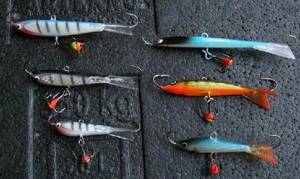
Ratlins
Bladeless wobblers are gaining more and more popularity among winter roads, as sometimes they catch better than other baits. However, there are some nuances here. The ratlin (vibe) of each specific model requires an individual approach and play, as, in other matters, with any summer wobblers in a spinning rod. On the first ice, pike perch reacts perfectly to ratlins, provided that the tackle is handled correctly. With skillful handling, vibes catch the usual spinners or balancers. Read more about winter fishing for pike perch with ratlins
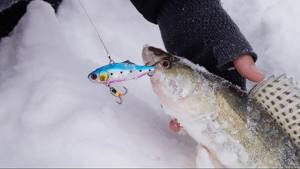
Fishing methods and bait
Each fisherman himself chooses the fishing method and the bait he will fish with, focusing on the preferences of the predator during fishing and the specifics of the reservoir.
Balance
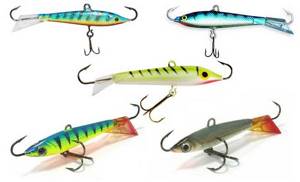
With the help of a balancer you can catch a “fanged one” both on a river and on a still body of water. This bait has a blade in the tail, thanks to which it can play not only under the hole, but also move 1–2 m to the side, attracting a predator from a long distance.
The wide play of the balancer limits its use in conditions where the bottom of the reservoir is very windy. When catching pike perch in winter with a balance beam, the angler must have a detachment with him, since this bait is equipped with several hooks and is subject to frequent snagging. Playing with a balancer looks like smooth rises and sharp drops of the rod with an amplitude of 20–30 cm.
Winter fishing for pike perch with a jig
“Fanged” jigs are caught on rivers with moderate currents. The weight of the jig is selected in such a way that it can reach the bottom, but at the same time is carried down by the flow of water. Armed with jig tackle, the angler will be able to fish not only the area under the hole, but also the area downstream, gradually stripping the line from the reel.
The following is attached to the hook of the jig:
- sprat;
- worm;
- artificial silicone nozzle made from “edible rubber”.
A winter fishing rod for pike perch when fishing with a jig should be equipped with an inertial-type reel and have a short, elastic nod. A fluorocarbon fishing line with a diameter of 0.18–0.25 mm is installed on the zander jig tackle.
Spoon

A vertical spoon is a traditional bait for catching fanged predators in winter. Pike-perch spoons are made from various metals:
- copper;
- silver;
- brass;
- cupronickel
A bright cambric or red cloth is put on the hook of the spinner, provoking the predator to bite. The game of a spinner is a sharp tossing and lowering of the bait with an amplitude of 20–50 cm. When fishing with a spinner, a winter fishing rod for pike perch is used, which has a hard whip that allows you to cut through the hard mouth of a predator.
Balda
Balda - this bait is more often used for fishing in still waters. It is used when the fish behaves passively and switches to feeding on aquatic insects.
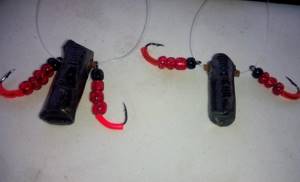
It is not difficult to construct a bulldozer:
- the main fishing line with a diameter of 0.17–0.20 mm is inserted into the eye of hook No. 5–3 (according to the international classification), while the tip of the hook should point upward;
- an oblong-shaped sinker with a hole in the upper part is put on the fishing line;
- a second hook is put on the fishing line, the tip of which should point in the direction opposite to the sinker;
- All elements are moved closer to each other, and a knot is knitted above them, forming a loop.
Thus, it turns out that all structural elements fixed in the loop move freely while the bait is playing, creating an imitation of an active aquatic insect. In order for this winter tackle for pike perch to attract a predator, during fishing it is necessary to constantly tap the canister on the bottom, creating a cloud of turbidity in the water.
How to catch pike perch using sprat
Recently, a lot of fish such as sprat have appeared in reservoirs, which appeal to the taste of pike perch. In some reservoirs, the “fanged” fish has completely switched to feeding on this fish. Many fishermen have begun to successfully use sprat to catch this predator in the winter. The fish are hooked on spinners, jigs and jig heads.
When fishing with a jig, the sprat is pierced with a hook at the base of the head. If caught with a jig head, the fish is pierced behind the naked body and in the middle of the body, which helps to better keep it on the hook.
Zherlitsa

Winter fishing gear for pike perch is highly effective, as it makes it possible to simultaneously fish a large area of water. The fisherman places several girders on the pond at once and waits for the fish to bite. If there is no bite within half an hour, all gear is moved to another promising area. The following are used as live bait for pike perch fishing:
- roach;
- ruff;
- gudgeon;
- bleak.
Live bait is attached to a single or double hook. Since pike perch do not have such sharp teeth as pike, anglers should avoid using metal leashes. Fluorocarbon fishing line with a thickness of 0.22–0.30 mm is used as a leader material.
Fishing with rattlins
Rattlins are a cross between a wobbler and a balancer. These baits have an active action that attracts predators from a great distance. Many rattlins have rattles in their bodies, which also help attract the “fanged one”. The technique of playing rattlin is similar to that used when fishing on a balance beam.
Fishing with silicone
With the advent of “edible” rubber, silicone baits began to be often used in winter pike perch fishing. They are used for catching fish in the current and are used in combination with a heavy pike-perch jig or a classic jig head.
Using the force of the current, the angler lowers the bait 20–30 m below the drilled hole, and then slowly, with pauses, pulls it back. For this fishing, both traditional twisters and vibrotails, as well as various imitations of leeches, are used. In winter, pike perch responds better to dark green and brown silicone.
Fishing with sprat
On the Volga and the cascades of its reservoirs, large tributaries, many pike-perch fish catch fanged fish using sprat. This can be done either actively, by playing with a fishing rod and a jig, or passively - using hooks and jigs. For the active method, the same tackle is used as for trolling, only instead of bait - a large pike-perch jig, selected by weight depending on the strength of the current and depth. Some reach up to 30-40 grams. However, you can also fish with a regular jig head of a suitable size.
The sprat is planted whole or in parts. Pike perch are attracted by the smell of this fish, which makes up a significant part of its natural diet. Simple at first glance, sprat fishing is full of nuances and features - how to catch and bait, play with bait, and so on. Read more about winter fishing for pike perch using sprat
Features of catching pike perch in winter
Winter fishing for pike perch, like open water fishing, involves a constant search for an active predator. In summer and autumn, it is much easier to look for “fanged” fish, since in the absence of ice, the angler manages to fish a large area of water. When fishing for pike perch from ice, the fisherman must constantly move around the reservoir and drill a large number of holes, which requires good physical preparation.
Pike perch fishing is more effective on the first ice. This is primarily due to the fact that drilling holes in thin ice is much easier, which means the angler can fish more promising places. Closer to the middle of winter, when the thickness of the ice increases, the pikeperch fisher should focus only on the most catchy points, where the active bite of the predator was previously observed, without wasting the short winter day and his energy searching for new pikeperch spots.
Zherlitsy and postavushi
Passive methods of catching pike perch on first ice work if the approximate water area where the fanged fish lives is known for certain. Such fishing for pike perch on the first ice is also possible along the edges, close to the feeding areas of the predator. Both ordinary fishing rods with live fish and fishing rods with a nod to a dead fish or sprat work.
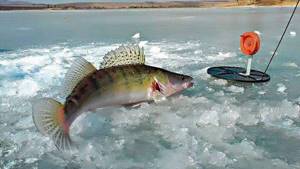
Naturally, the equipment for pike perch is different from that of pike. In addition, you need to take into account depth and current. On rivers, equipment with an end weight and a diversion leash is used. The same equipment is installed on supplies. The difference is in the bite tracking mechanism. On fishing rods it is determined by the nod. It’s more convenient to work with a fishing rod; if it doesn’t take you to a standstill, you can come up and play along with bait. Article about winter fishing for pike perch with girders
